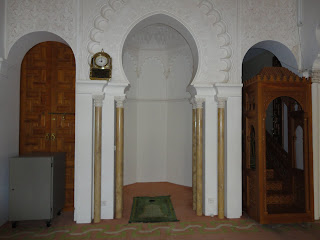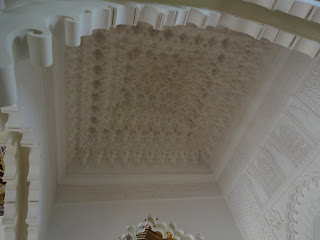Today, my Islamic Art and Architecture class visited the Al Akhawayn Mosque. Throughout the semester, we have studied the different components of mosque architecture. As we entered, the girls covered their hair with scarves and everyone removed their shoes. Dr. Ennaheid explained that unlike most, the Akhawayn Mosque has glass on its doors and windows, which protects the inside from the lovely weather of Ifrane.
Near the entrance, there is a large poster of the Kaaba in Mecca.
My professor explained that the mosque is Medinan in style. He pulled out the minbar, a large wooden chair-like structure with stairs from which the imam (prayer leader) delivers the sermon, or khutba. The minbar is stored in a small open room to the right of the mihrab, a niche which denotes the qibla. The qibla faces the Kaaba, the direction in which Muslims are supposed to pray.
According to Dr. Ennaheid, the minbar is usually used during Friday services. It allows for the amplification of the imam's voice. He also mentioned the anaza, a respondent who stands near the back of the mosque and repeats the sermon if the congregation is particularly large.
The ceiling in front of the mihrab acts as a dome, which amplifies the voice of the imam. The decoration is completed entirely in plaster, so the artisans had to work quickly to complete it.
He showed us a dry-erase board stored in the corner in an area used as a kuttab, or space for teaching Muslim children the basics of the Islamic faith. After most of the other Moroccan students left, Dr. Ennaheid led us to the bookshelf with different translations of the Quran, including one in English. He noted that there were incidents in Morocco of misprintings of the Quran, which led the government to outlaw the printing of the Quran in Morocco. He pointed out the Magrebi style of Arabic script in some of the books, as opposed to those printed in Saudi Arabia.
Near the entrance, there is a large poster of the Kaaba in Mecca.
My professor explained that the mosque is Medinan in style. He pulled out the minbar, a large wooden chair-like structure with stairs from which the imam (prayer leader) delivers the sermon, or khutba. The minbar is stored in a small open room to the right of the mihrab, a niche which denotes the qibla. The qibla faces the Kaaba, the direction in which Muslims are supposed to pray.
According to Dr. Ennaheid, the minbar is usually used during Friday services. It allows for the amplification of the imam's voice. He also mentioned the anaza, a respondent who stands near the back of the mosque and repeats the sermon if the congregation is particularly large.
He pointed out the more elaborate decoration on the "T-shape" of the mosque, characteristic of the Medinan style. In the Al Akhawayn Mosque, this shape is formed with nine isles and an axial nave, which intersects the isles in a perpendicular fashion.
We were standing in the part of the mosque generally reserved for men during prayer. The women's side was separated with mashrabiya, a kind of lattice woodwork which offers a barrier or partition.
The ceiling in front of the mihrab acts as a dome, which amplifies the voice of the imam. The decoration is completed entirely in plaster, so the artisans had to work quickly to complete it.
He showed us a dry-erase board stored in the corner in an area used as a kuttab, or space for teaching Muslim children the basics of the Islamic faith. After most of the other Moroccan students left, Dr. Ennaheid led us to the bookshelf with different translations of the Quran, including one in English. He noted that there were incidents in Morocco of misprintings of the Quran, which led the government to outlaw the printing of the Quran in Morocco. He pointed out the Magrebi style of Arabic script in some of the books, as opposed to those printed in Saudi Arabia.












No comments:
Post a Comment